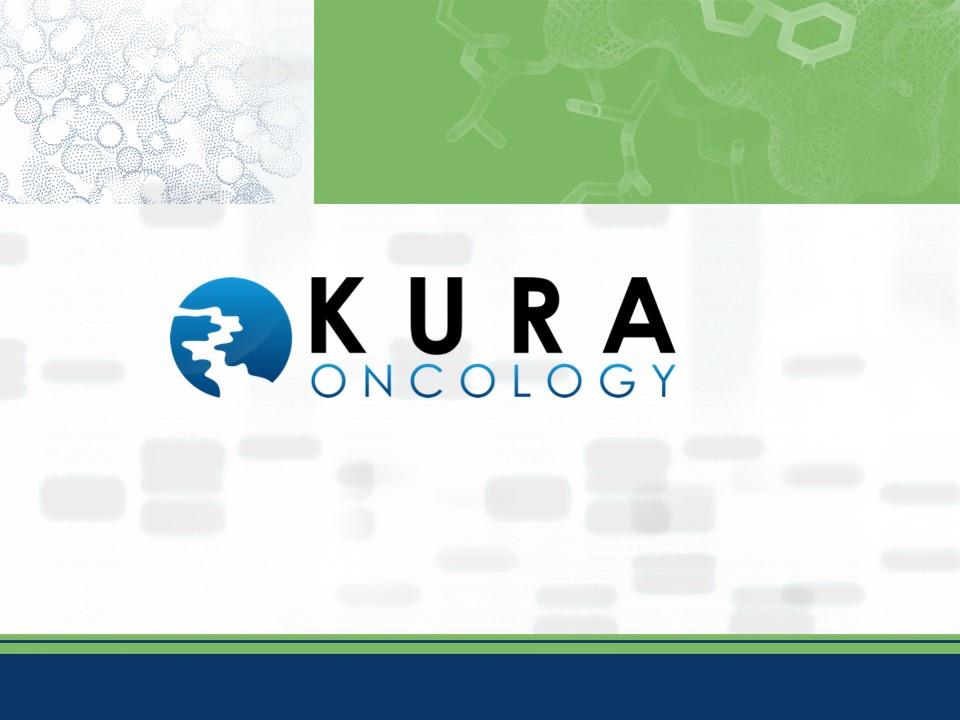Attached files
| file | filename |
|---|---|
| 8-K - 8-K - Kura Oncology, Inc. | kura-8k_20150811.htm |
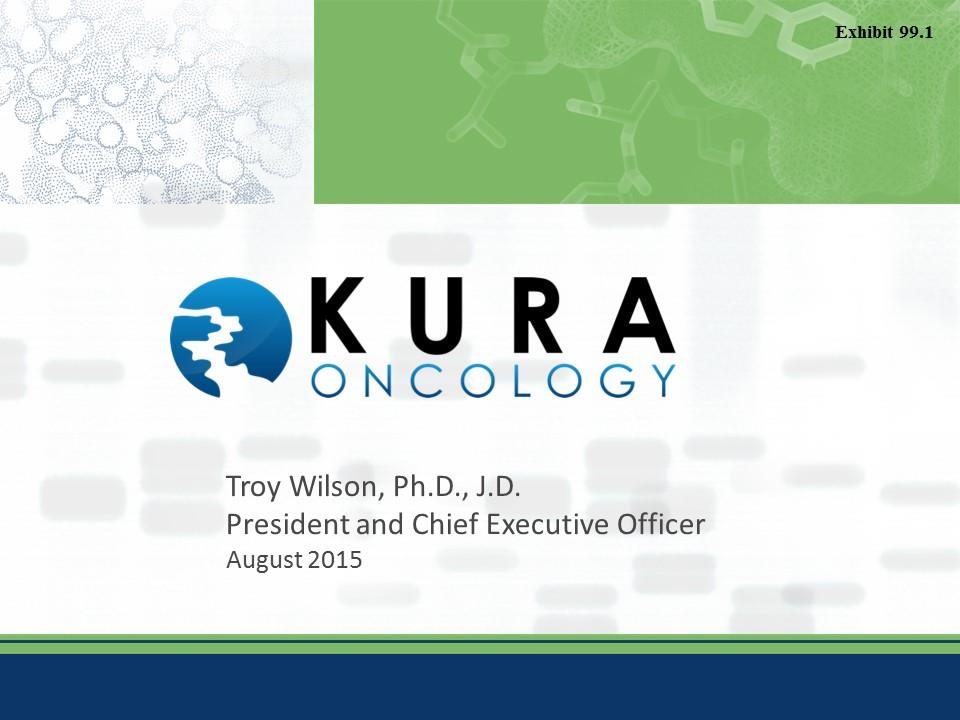
Troy Wilson, Ph.D., J.D. President and Chief Executive Officer August 2015 Exhibit 99.1
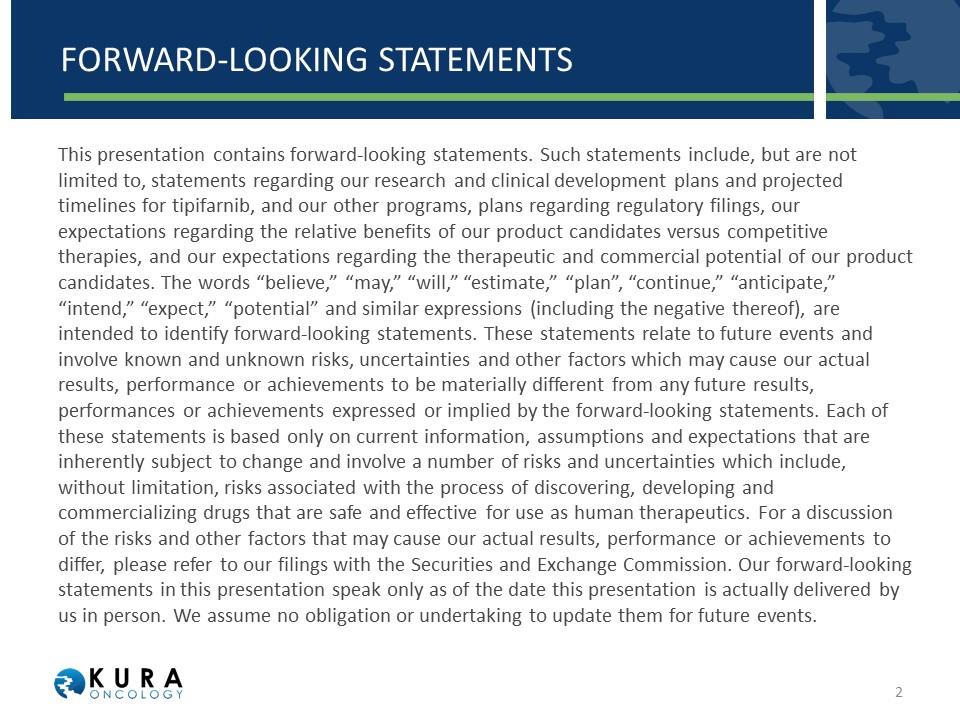
Forward-looking statements This presentation contains forward-looking statements. Such statements include, but are not limited to, statements regarding our research and clinical development plans and projected timelines for tipifarnib, and our other programs, plans regarding regulatory filings, our expectations regarding the relative benefits of our product candidates versus competitive therapies, and our expectations regarding the therapeutic and commercial potential of our product candidates. The words “believe,” “may,” “will,” “estimate,” “plan”, “continue,” “anticipate,” “intend,” “expect,” “potential” and similar expressions (including the negative thereof), are intended to identify forward-looking statements. These statements relate to future events and involve known and unknown risks, uncertainties and other factors which may cause our actual results, performance or achievements to be materially different from any future results, performances or achievements expressed or implied by the forward-looking statements. Each of these statements is based only on current information, assumptions and expectations that are inherently subject to change and involve a number of risks and uncertainties which include, without limitation, risks associated with the process of discovering, developing and commercializing drugs that are safe and effective for use as human therapeutics. For a discussion of the risks and other factors that may cause our actual results, performance or achievements to differ, please refer to our filings with the Securities and Exchange Commission. Our forward-looking statements in this presentation speak only as of the date this presentation is actually delivered by us in person. We assume no obligation or undertaking to update them for future events.
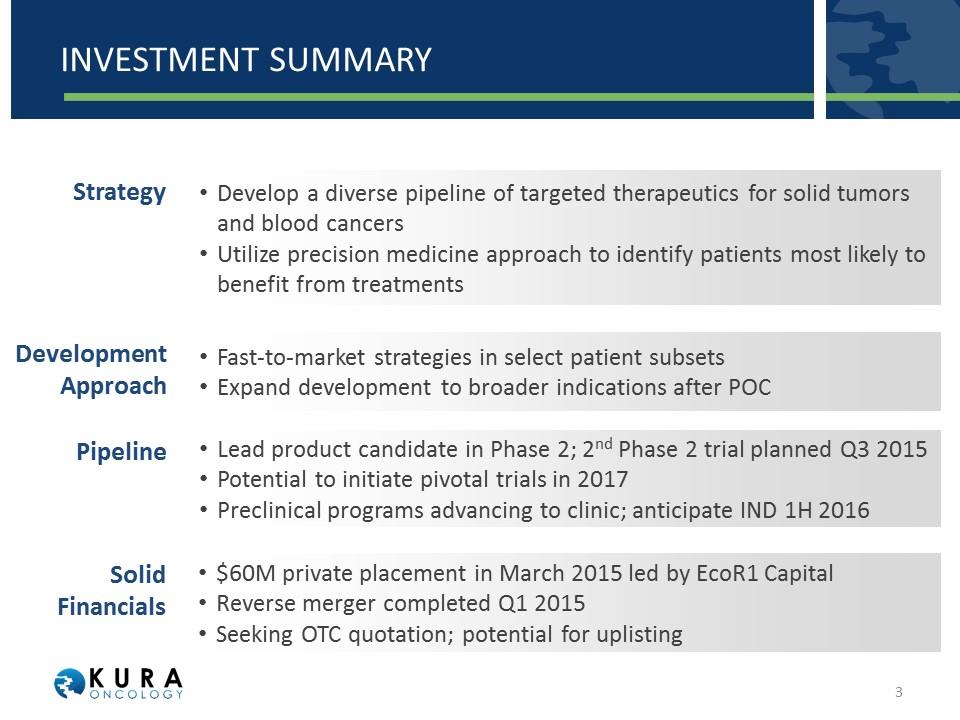
Investment summary Develop a diverse pipeline of targeted therapeutics for solid tumors and blood cancers Utilize precision medicine approach to identify patients most likely to benefit from treatments Strategy Development Approach Pipeline Solid Financials Fast-to-market strategies in select patient subsets Expand development to broader indications after POC Lead product candidate in Phase 2; 2nd Phase 2 trial planned Q3 2015 Potential to initiate pivotal trials in 2017 Preclinical programs advancing to clinic; anticipate IND 1H 2016 $60M private placement in March 2015 led by EcoR1 Capital Reverse merger completed Q1 2015 Seeking OTC quotation; potential for uplisting
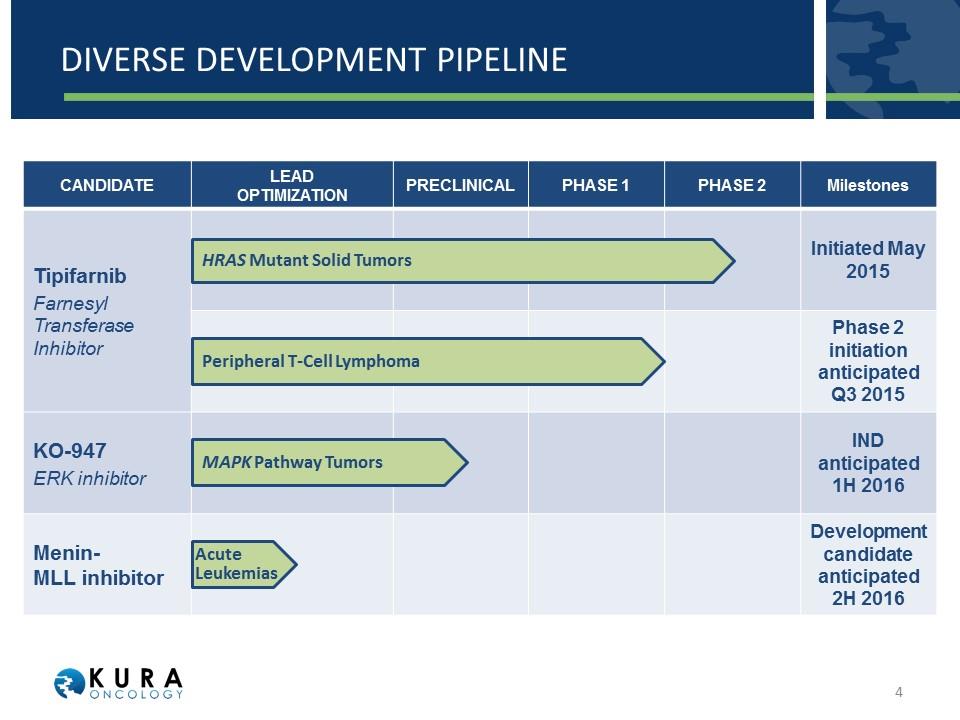
Diverse Development Pipeline CANDIDATE LEAD OPTIMIZATION PRECLINICAL PHASE 1 PHASE 2 Milestones Tipifarnib Farnesyl Transferase Inhibitor Initiated May 2015 Phase 2 initiation anticipated Q3 2015 KO-947 ERK inhibitor IND anticipated 1H 2016 Menin- MLL inhibitor Development candidate anticipated 2H 2016 HRAS Mutant Solid Tumors Peripheral T-Cell Lymphoma MAPK Pathway Tumors Acute Leukemias
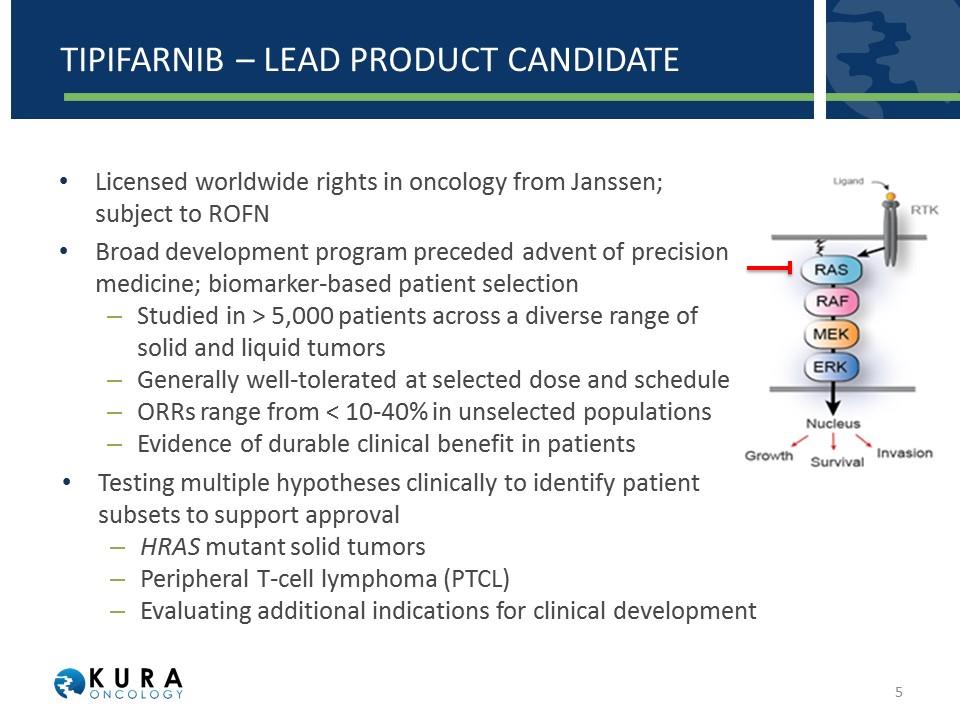
Tipifarnib – LEAD Product CANDIDATE Licensed worldwide rights in oncology from Janssen; subject to ROFN Broad development program preceded advent of precision medicine; biomarker-based patient selection Studied in > 5,000 patients across a diverse range of solid and liquid tumors Generally well-tolerated at selected dose and schedule ORRs range from < 10-40% in unselected populations Evidence of durable clinical benefit in patients Testing multiple hypotheses clinically to identify patient subsets to support approval HRAS mutant solid tumors Peripheral T-cell lymphoma (PTCL) Evaluating additional indications for clinical development
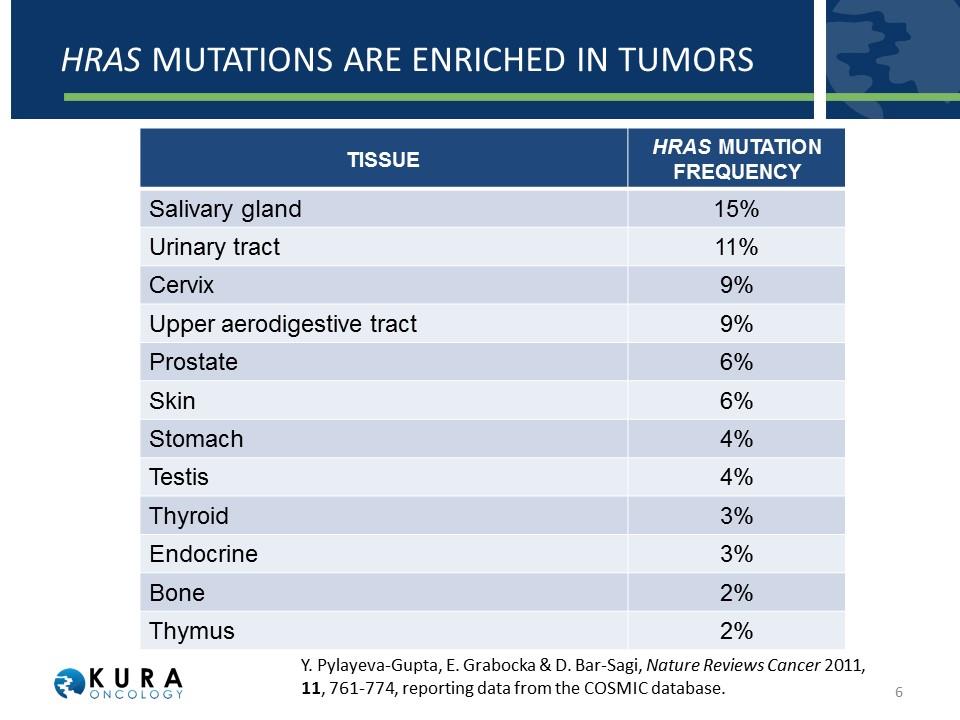
HRAS Mutations ARE Enriched in Tumors TISSUE HRAS MUTATION FREQUENCY Salivary gland 15% Urinary tract 11% Cervix 9% Upper aerodigestive tract 9% Prostate 6% Skin 6% Stomach 4% Testis 4% Thyroid 3% Endocrine 3% Bone 2% Thymus 2% Y. Pylayeva-Gupta, E. Grabocka & D. Bar-Sagi, Nature Reviews Cancer 2011, 11, 761-774, reporting data from the COSMIC database.
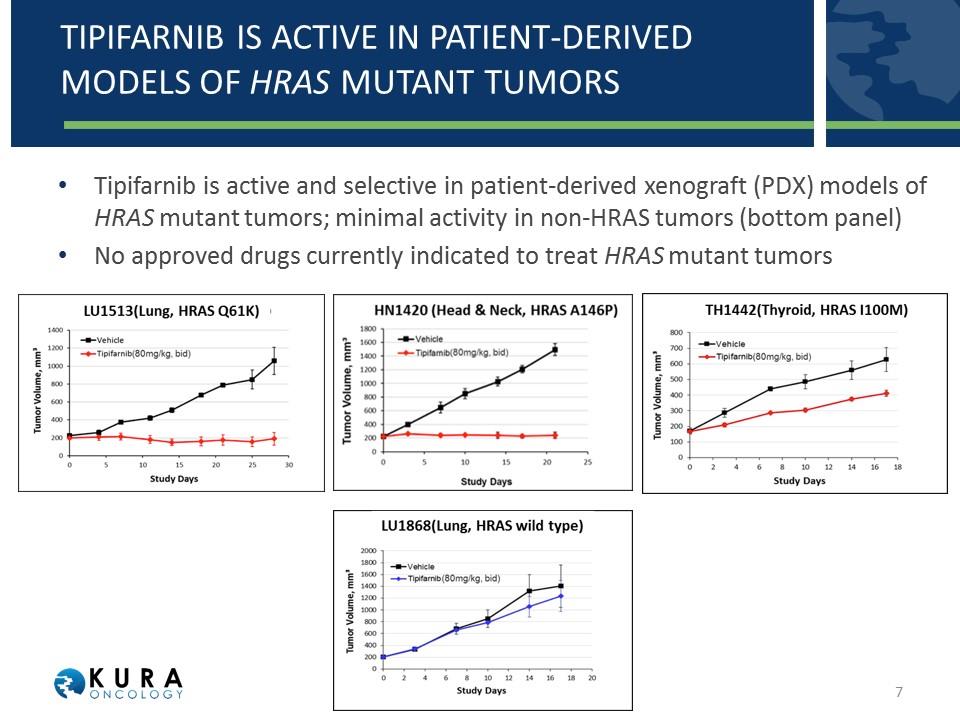
Tipifarnib is active in patient-derived models of HRAS mutant Tumors Tipifarnib is active and selective in patient-derived xenograft (PDX) models of HRAS mutant tumors; minimal activity in non-HRAS tumors (bottom panel) No approved drugs currently indicated to treat HRAS mutant tumors
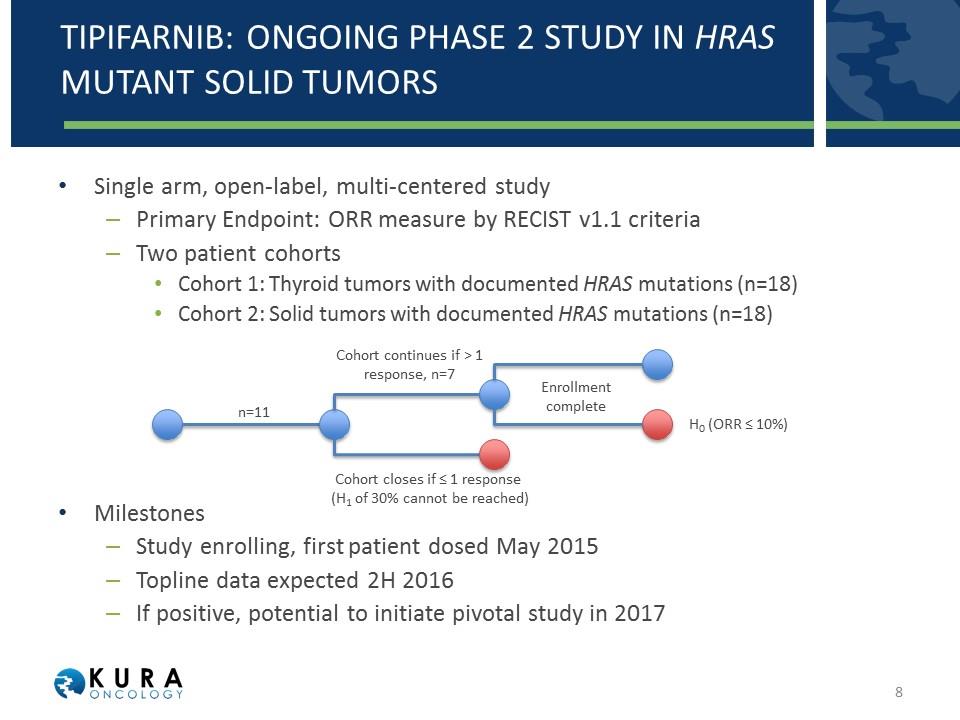
Tipifarnib: ongoing Phase 2 study in HRAS mutant solid tumors Single arm, open-label, multi-centered study Primary Endpoint: ORR measure by RECIST v1.1 criteria Two patient cohorts Cohort 1: Thyroid tumors with documented HRAS mutations (n=18) Cohort 2: Solid tumors with documented HRAS mutations (n=18) Milestones Study enrolling, first patient dosed May 2015 Topline data expected 2H 2016 If positive, potential to initiate pivotal study in 2017 n=11 H0 (ORR ≤ 10%) Cohort continues if > 1 response, n=7 Cohort closes if ≤ 1 response (H1 of 30% cannot be reached) Enrollment complete
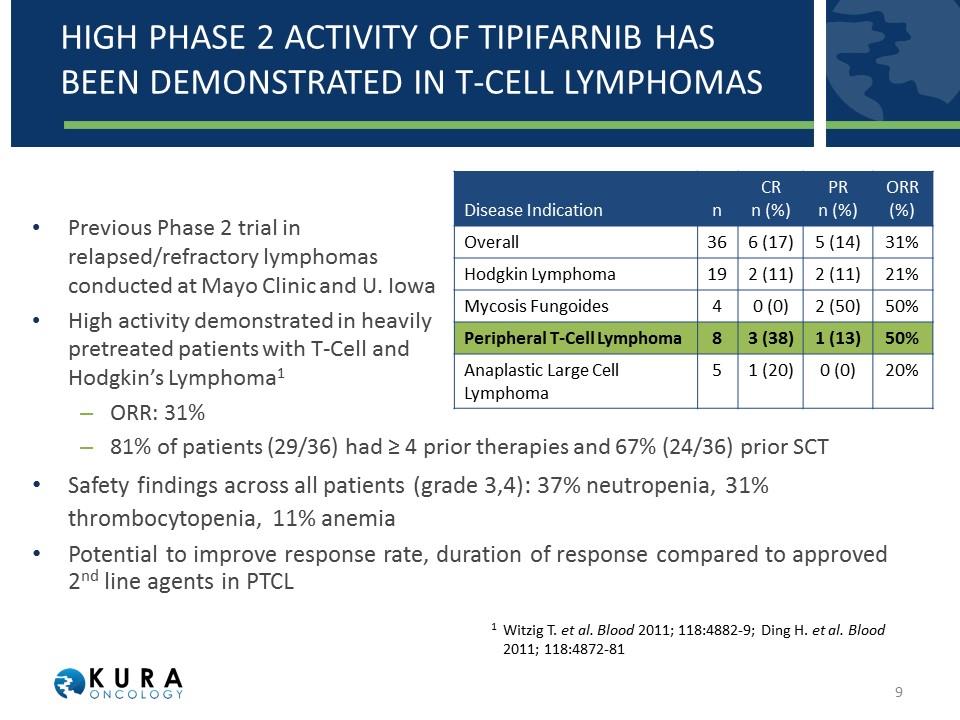
High Phase 2 Activity of Tipifarnib Has Been Demonstrated in T-Cell Lymphomas Previous Phase 2 trial in relapsed/refractory lymphomas conducted at Mayo Clinic and U. Iowa High activity demonstrated in heavily pretreated patients with T-Cell and Hodgkin’s Lymphoma1 ORR: 31% Disease Indication n CR n (%) PR n (%) ORR (%) Overall 36 6 (17) 5 (14) 31% Hodgkin Lymphoma 19 2 (11) 2 (11) 21% Mycosis Fungoides 4 0 (0) 2 (50) 50% Peripheral T-Cell Lymphoma 8 3 (38) 1 (13) 50% Anaplastic Large Cell Lymphoma 5 1 (20) 0 (0) 20% 81% of patients (29/36) had ≥ 4 prior therapies and 67% (24/36) prior SCT Safety findings across all patients (grade 3,4): 37% neutropenia, 31% thrombocytopenia, 11% anemia Potential to improve response rate, duration of response compared to approved 2nd line agents in PTCL 1 Witzig T. et al. Blood 2011; 118:4882-9; Ding H. et al. Blood 2011; 118:4872-81
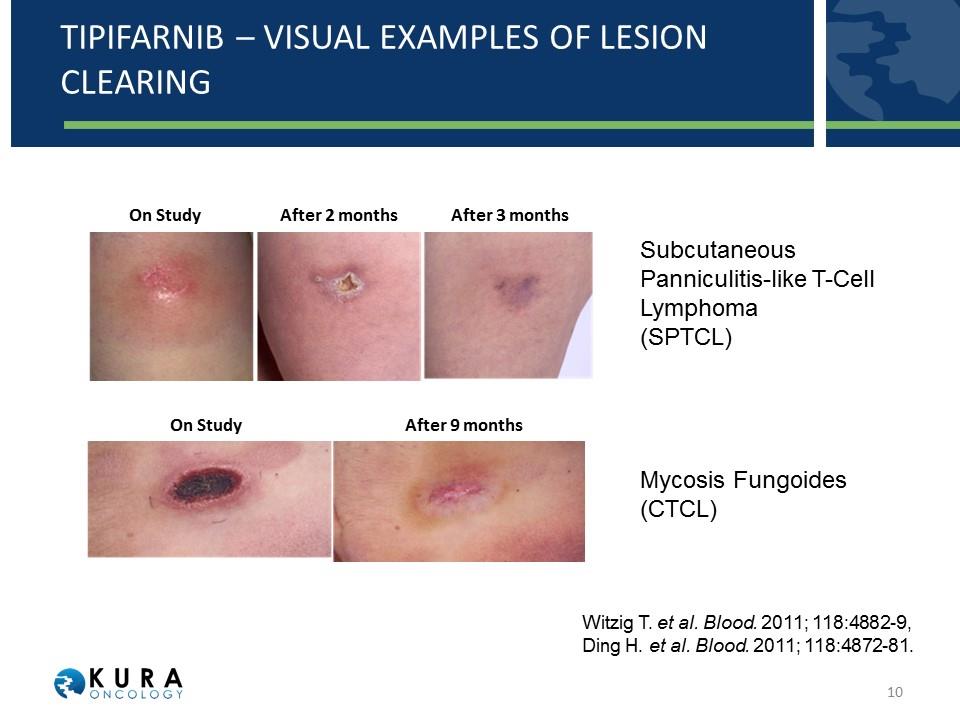
Tipifarnib – Visual examples of lesion clearing Witzig T. et al. Blood. 2011; 118:4882-9, Ding H. et al. Blood. 2011; 118:4872-81. Subcutaneous Panniculitis-like T-Cell Lymphoma (SPTCL) Mycosis Fungoides (CTCL) On Study After 2 months After 3 months On Study After 9 months
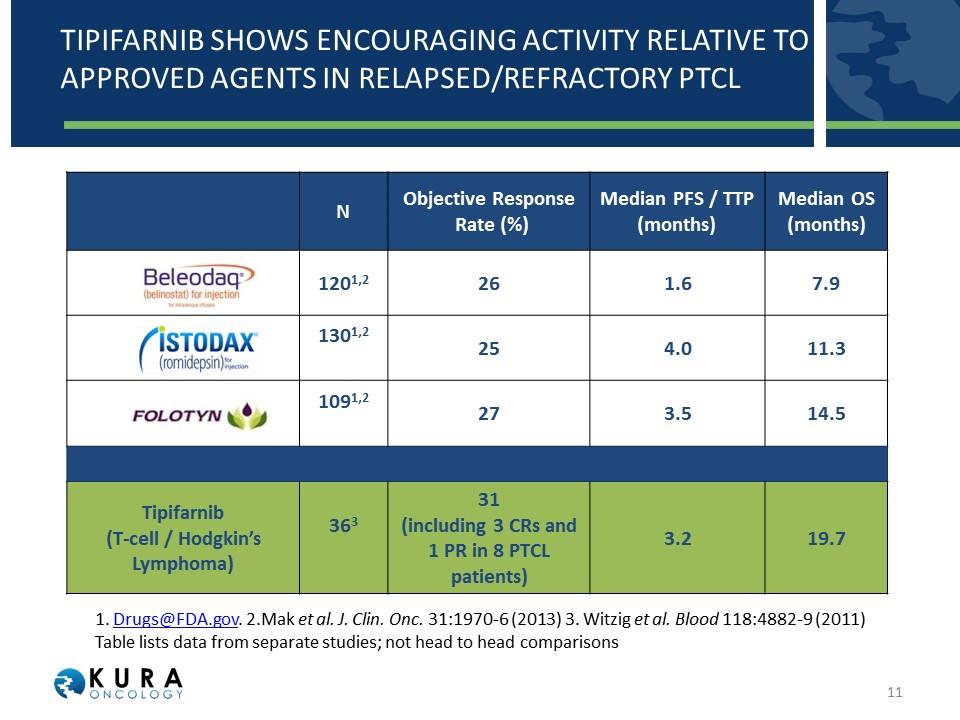
Tipifarnib Shows Encouraging Activity relative to Approved Agents in Relapsed/Refractory PTCL N Objective Response Rate (%) Median PFS / TTP (months) Median OS (months) 1201,2 26 1.6 7.9 1301,2 25 4.0 11.3 1091,2 27 3.5 14.5 Tipifarnib (T-cell / Hodgkin’s Lymphoma) 363 31 (including 3 CRs and 1 PR in 8 PTCL patients) 3.2 19.7 1. Drugs@FDA.gov. 2.Mak et al. J. Clin. Onc. 31:1970-6 (2013) 3. Witzig et al. Blood 118:4882-9 (2011) Table lists data from separate studies; not head to head comparisons
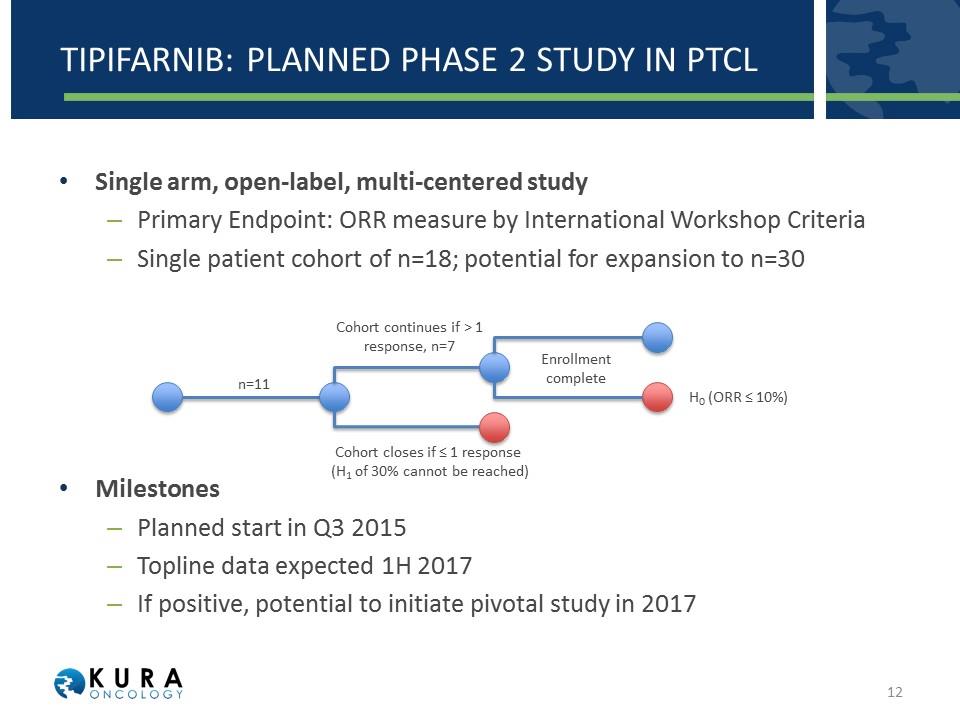
Tipifarnib: Planned Phase 2 study in PTCL Single arm, open-label, multi-centered study Primary Endpoint: ORR measure by International Workshop Criteria Single patient cohort of n=18; potential for expansion to n=30 Milestones Planned start in Q3 2015 Topline data expected 1H 2017 If positive, potential to initiate pivotal study in 2017 n=11 H0 (ORR ≤ 10%) Cohort continues if > 1 response, n=7 Cohort closes if ≤ 1 response (H1 of 30% cannot be reached) Enrollment complete
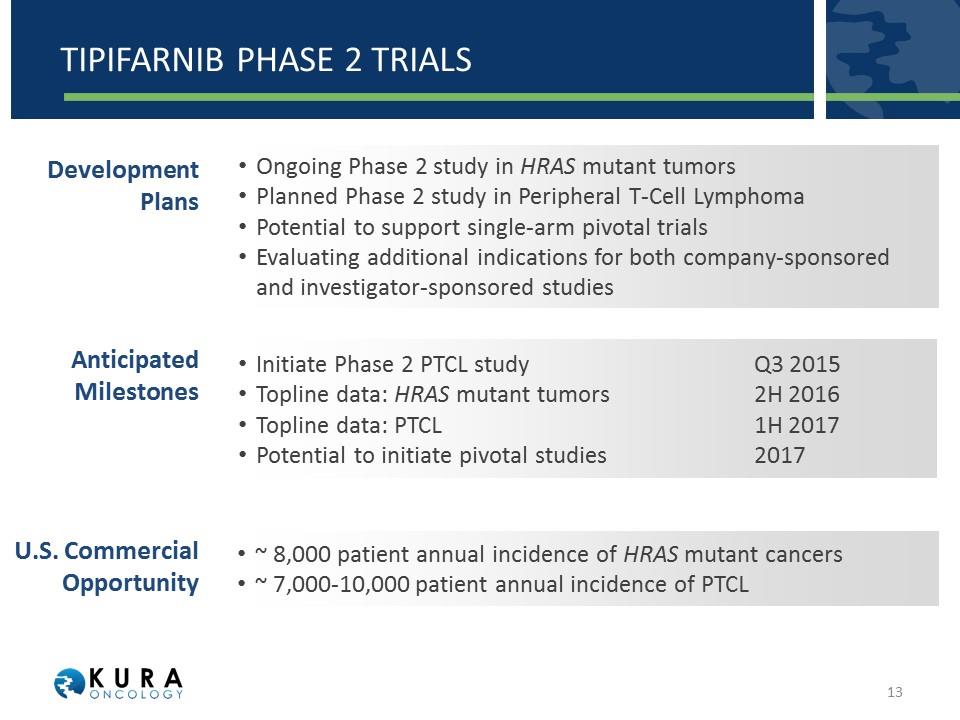
Tipifarnib phase 2 trials Ongoing Phase 2 study in HRAS mutant tumors Planned Phase 2 study in Peripheral T-Cell Lymphoma Potential to support single-arm pivotal trials Evaluating additional indications for both company-sponsored and investigator-sponsored studies Development Plans Anticipated Milestones U.S. Commercial Opportunity Initiate Phase 2 PTCL studyQ3 2015 Topline data: HRAS mutant tumors2H 2016 Topline data: PTCL1H 2017 Potential to initiate pivotal studies2017 ~ 8,000 patient annual incidence of HRAS mutant cancers ~ 7,000-10,000 patient annual incidence of PTCL
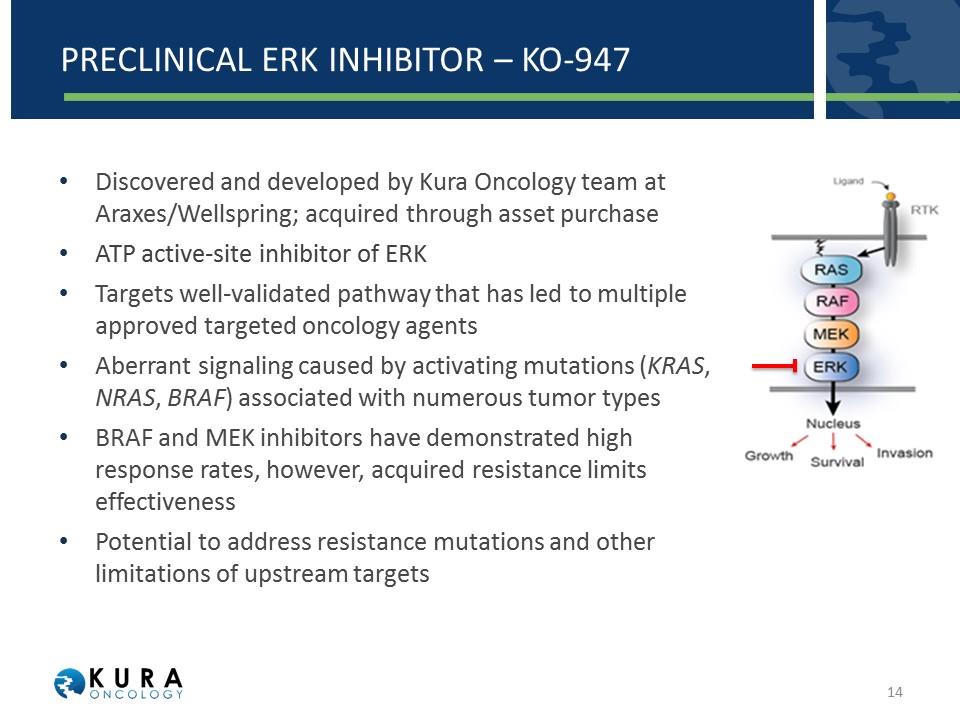
Preclinical erk inhibitor – ko-947 Discovered and developed by Kura Oncology team at Araxes/Wellspring; acquired through asset purchase ATP active-site inhibitor of ERK Targets well-validated pathway that has led to multiple approved targeted oncology agents Aberrant signaling caused by activating mutations (KRAS, NRAS, BRAF) associated with numerous tumor types BRAF and MEK inhibitors have demonstrated high response rates, however, acquired resistance limits effectiveness Potential to address resistance mutations and other limitations of upstream targets
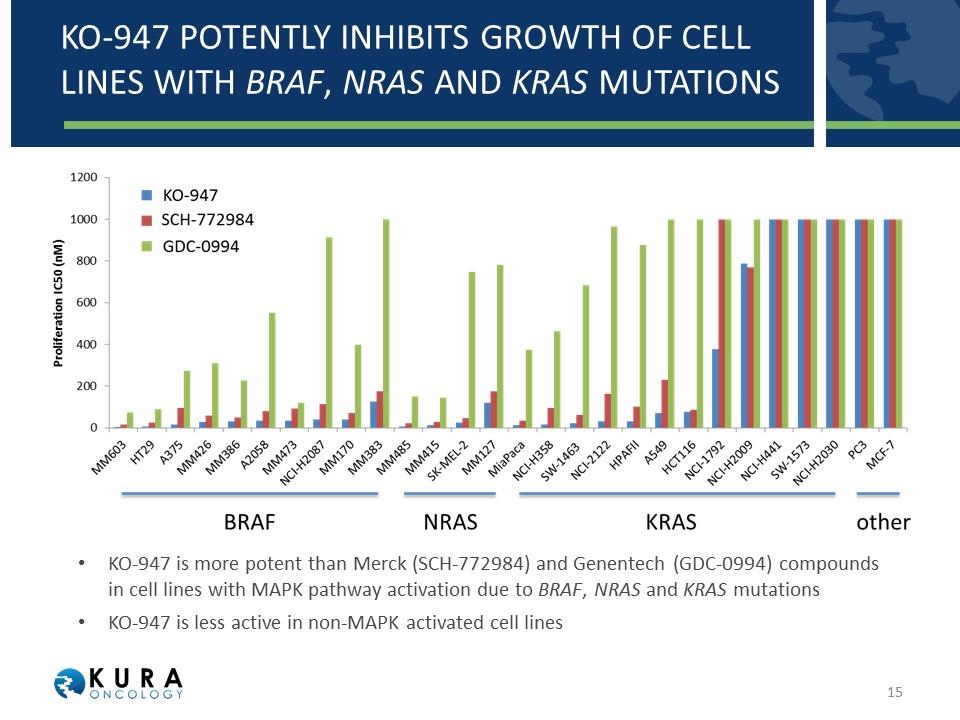
KO-947 Potently Inhibits Growth of Cell Lines with BRAF, NRAS and KRAS Mutations KO-947 is more potent than Merck (SCH-772984) and Genentech (GDC-0994) compounds in cell lines with MAPK pathway activation due to BRAF, NRAS and KRAS mutations KO-947 is less active in non-MAPK activated cell lines
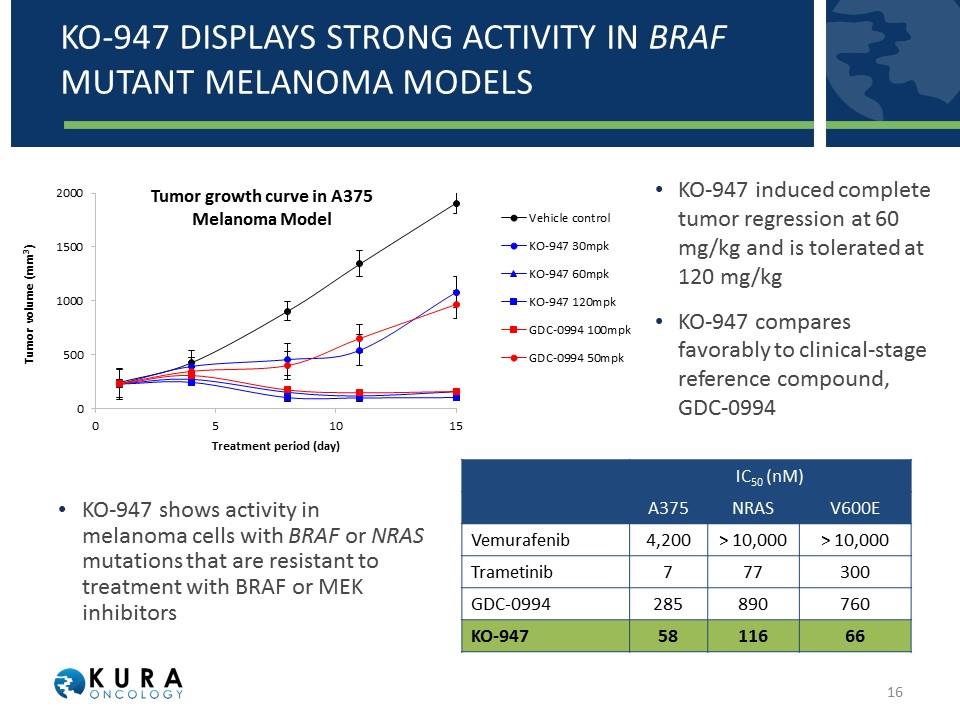
KO-947 DISPLAYS STRONG ACTIVITY IN BRAF MUTANT MELANOMA MODELS KO-947 shows activity in melanoma cells with BRAF or NRAS mutations that are resistant to treatment with BRAF or MEK inhibitors IC50 (nM) A375 NRAS V600E Vemurafenib 4,200 > 10,000 > 10,000 Trametinib 7 77 300 GDC-0994 285 890 760 KO-947 58 116 66 KO-947 induced complete tumor regression at 60 mg/kg and is tolerated at 120 mg/kg KO-947 compares favorably to clinical-stage reference compound, GDC-0994
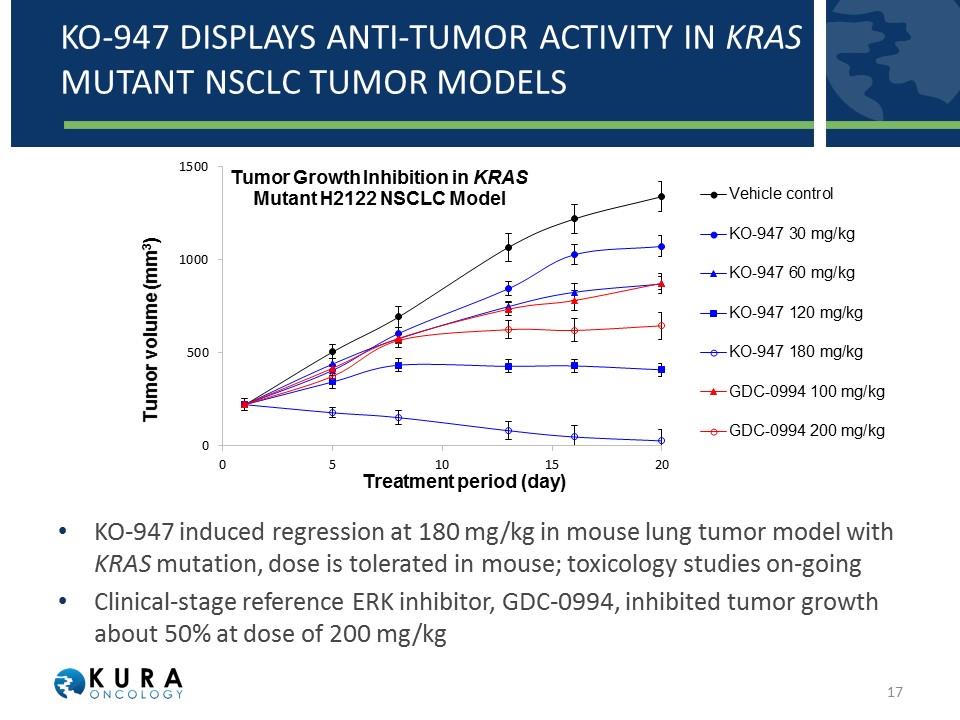
KO-947 Displays Anti-Tumor Activity in KRAS Mutant NSCLC Tumor Models KO-947 induced regression at 180 mg/kg in mouse lung tumor model with KRAS mutation, dose is tolerated in mouse; toxicology studies on-going Clinical-stage reference ERK inhibitor, GDC-0994, inhibited tumor growth about 50% at dose of 200 mg/kg
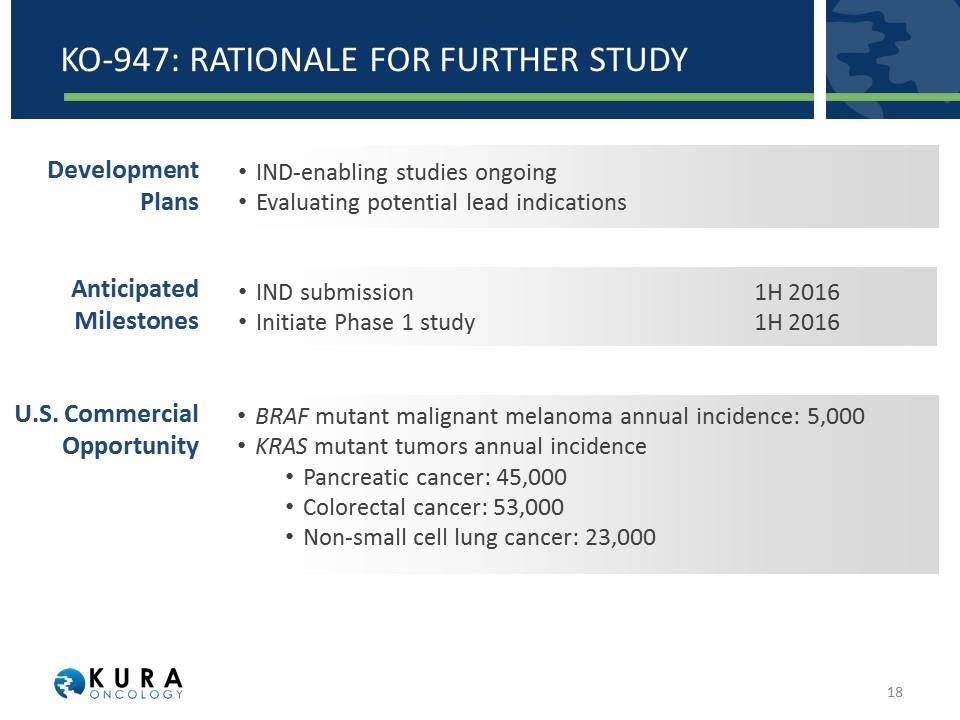
KO-947: RATIONALE FOR FURTHER STUDY IND-enabling studies ongoing Evaluating potential lead indications Development Plans Anticipated Milestones U.S. Commercial Opportunity IND submission1H 2016 Initiate Phase 1 study1H 2016 BRAF mutant malignant melanoma annual incidence: 5,000 KRAS mutant tumors annual incidence Pancreatic cancer: 45,000 Colorectal cancer: 53,000 Non-small cell lung cancer: 23,000
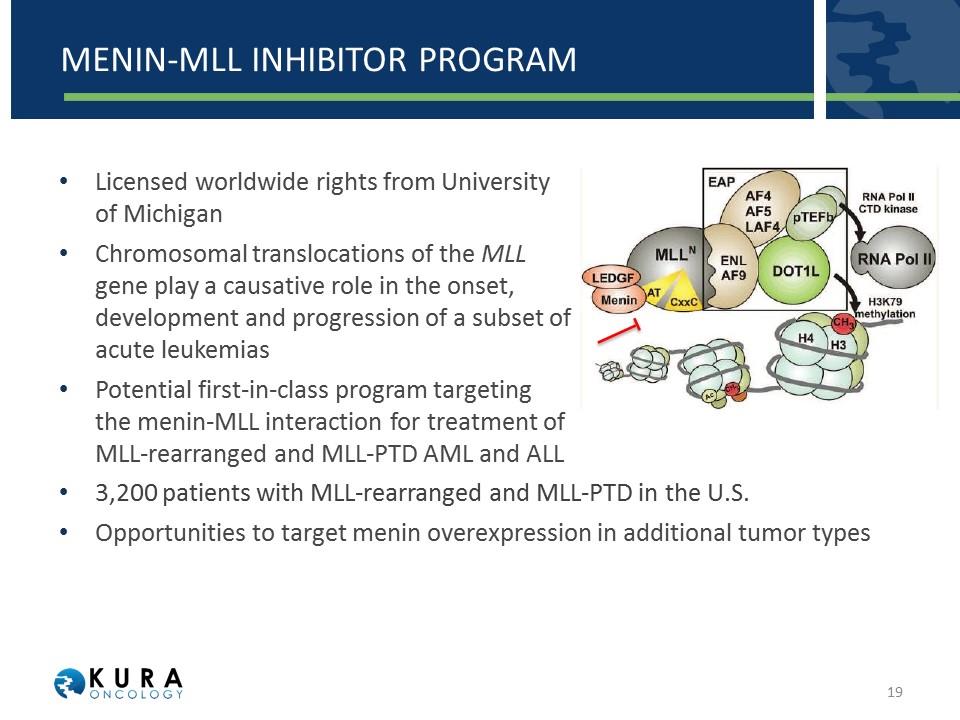
Menin-mll inhibitor program Licensed worldwide rights from University of Michigan Chromosomal translocations of the MLL gene play a causative role in the onset, development and progression of a subset of acute leukemias Potential first-in-class program targeting the menin-MLL interaction for treatment of MLL-rearranged and MLL-PTD AML and ALL 3,200 patients with MLL-rearranged and MLL-PTD in the U.S. Opportunities to target menin overexpression in additional tumor types
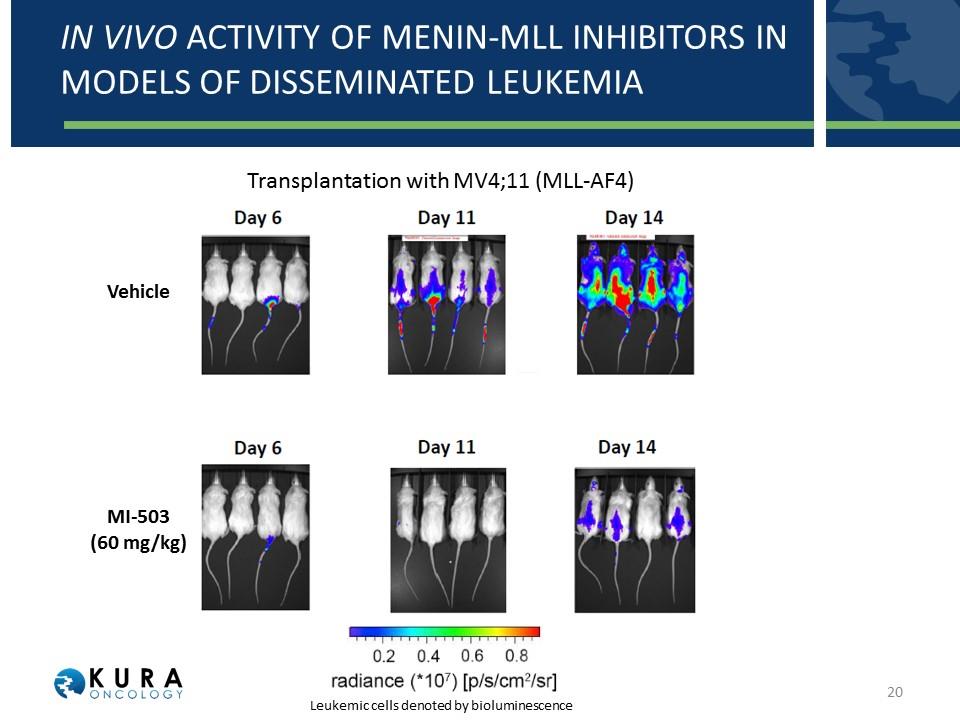
In Vivo Activity of Menin-MLL Inhibitors in Models of disseminated leukemia Vehicle MI-503 (60 mg/kg) Transplantation with MV4;11 (MLL-AF4) Leukemic cells denoted by bioluminescence
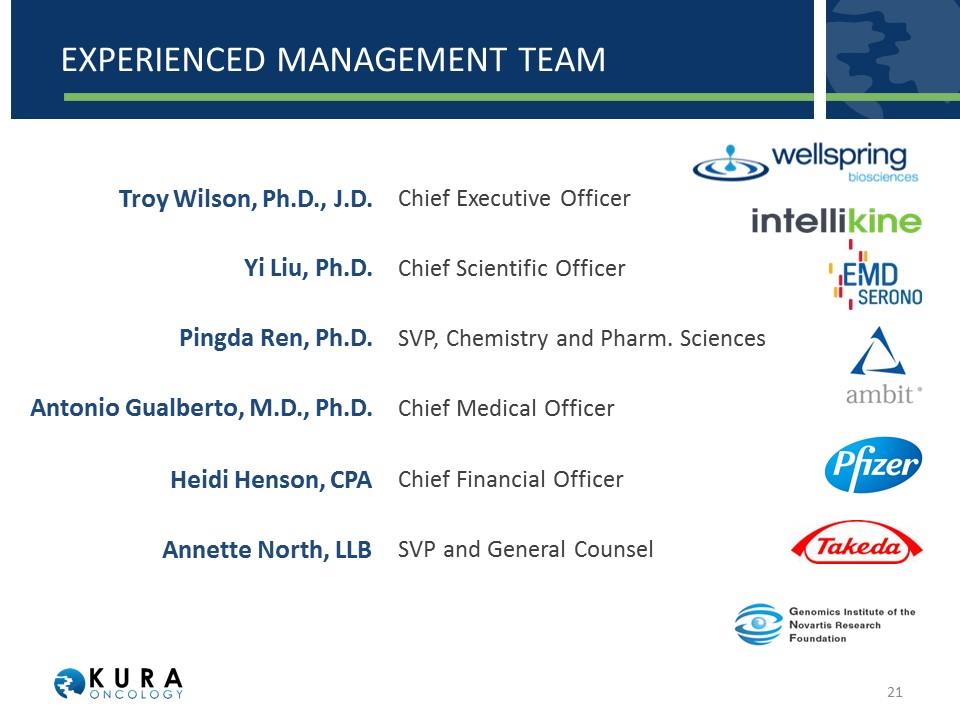
Experienced management team Chief Executive Officer Troy Wilson, Ph.D., J.D. Chief Scientific Officer Yi Liu, Ph.D. SVP, Chemistry and Pharm. Sciences Pingda Ren, Ph.D. Chief Medical Officer Antonio Gualberto, M.D., Ph.D. Chief Financial Officer Heidi Henson, CPA SVP and General Counsel Annette North, LLB
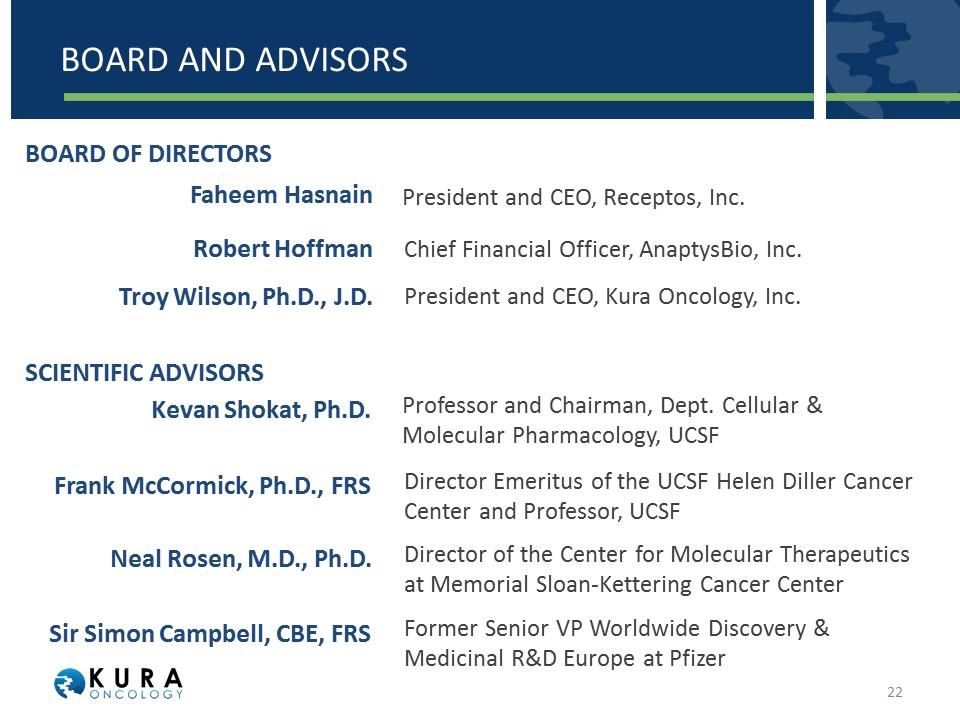
Board and advisors President and CEO, Receptos, Inc. Faheem Hasnain Chief Financial Officer, AnaptysBio, Inc. Robert Hoffman President and CEO, Kura Oncology, Inc. Troy Wilson, Ph.D., J.D. Professor and Chairman, Dept. Cellular & Molecular Pharmacology, UCSF Kevan Shokat, Ph.D. Director Emeritus of the UCSF Helen Diller Cancer Center and Professor, UCSF Frank McCormick, Ph.D., FRS Director of the Center for Molecular Therapeutics at Memorial Sloan-Kettering Cancer Center Neal Rosen, M.D., Ph.D. Former Senior VP Worldwide Discovery & Medicinal R&D Europe at Pfizer Sir Simon Campbell, CBE, FRS BOARD OF DIRECTORS SCIENTIFIC ADVISORS
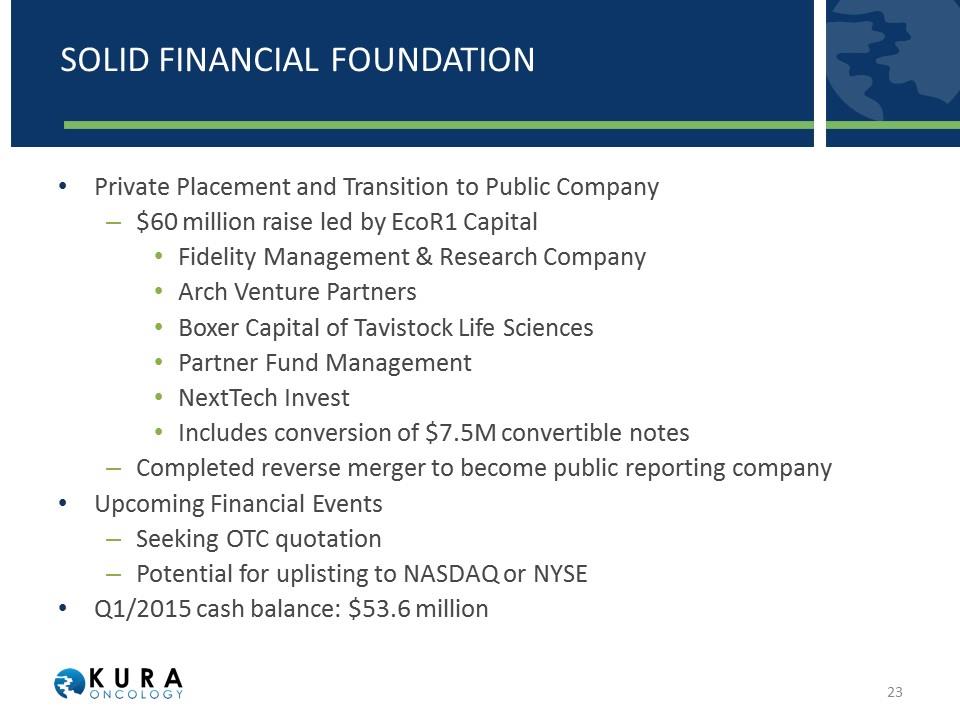
SOLID FINANCIAL FOUNDATION Private Placement and Transition to Public Company $60 million raise led by EcoR1 Capital Fidelity Management & Research Company Arch Venture Partners Boxer Capital of Tavistock Life Sciences Partner Fund Management NextTech Invest Includes conversion of $7.5M convertible notes Completed reverse merger to become public reporting company Upcoming Financial Events Seeking OTC quotation Potential for uplisting to NASDAQ or NYSE Q1/2015 cash balance: $53.6 million
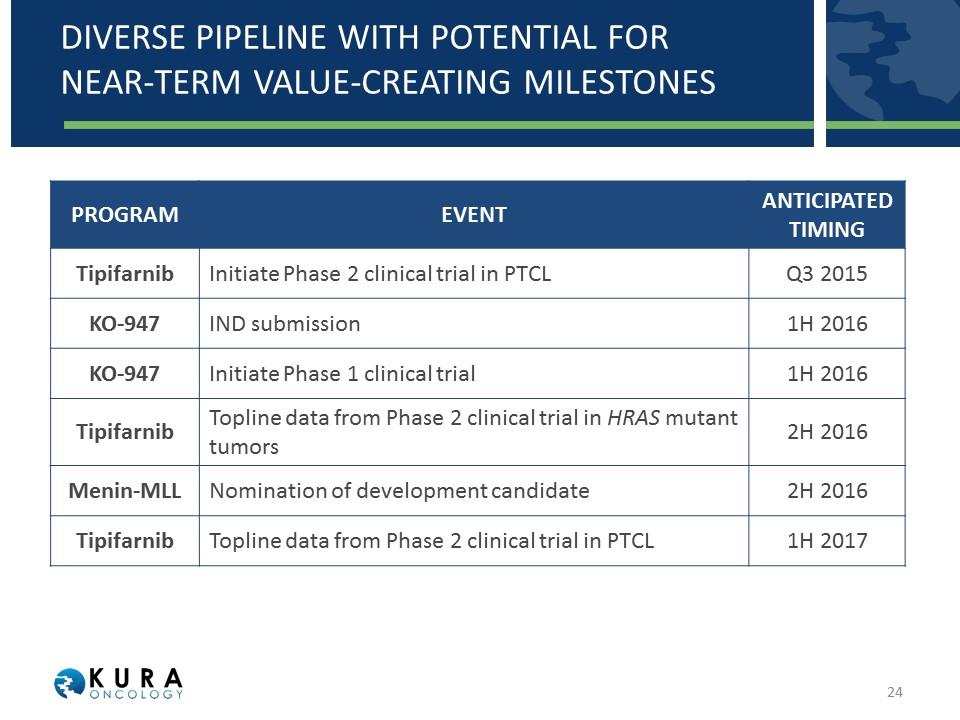
Diverse pipeline with potential for near-term value-creating milestones PROGRAM EVENT ANTICIPATED TIMING Tipifarnib Initiate Phase 2 clinical trial in PTCL Q3 2015 KO-947 IND submission 1H 2016 KO-947 Initiate Phase 1 clinical trial 1H 2016 Tipifarnib Topline data from Phase 2 clinical trial in HRAS mutant tumors 2H 2016 Menin-MLL Nomination of development candidate 2H 2016 Tipifarnib Topline data from Phase 2 clinical trial in PTCL 1H 2017
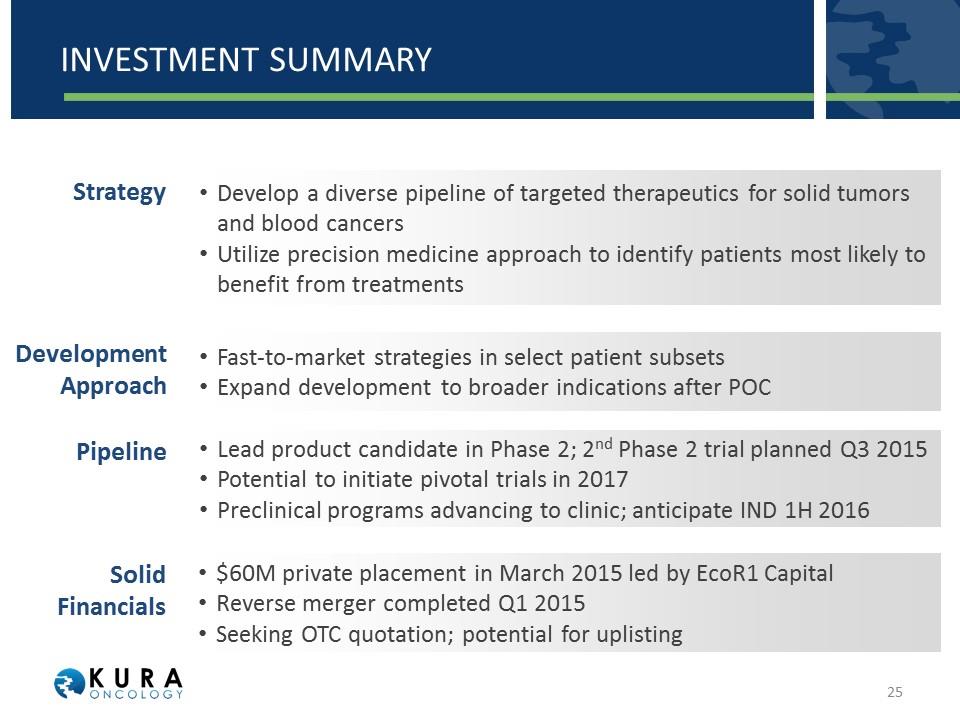
Investment summary Develop a diverse pipeline of targeted therapeutics for solid tumors and blood cancers Utilize precision medicine approach to identify patients most likely to benefit from treatments Strategy Development Approach Pipeline Solid Financials Fast-to-market strategies in select patient subsets Expand development to broader indications after POC Lead product candidate in Phase 2; 2nd Phase 2 trial planned Q3 2015 Potential to initiate pivotal trials in 2017 Preclinical programs advancing to clinic; anticipate IND 1H 2016 $60M private placement in March 2015 led by EcoR1 Capital Reverse merger completed Q1 2015 Seeking OTC quotation; potential for uplisting
